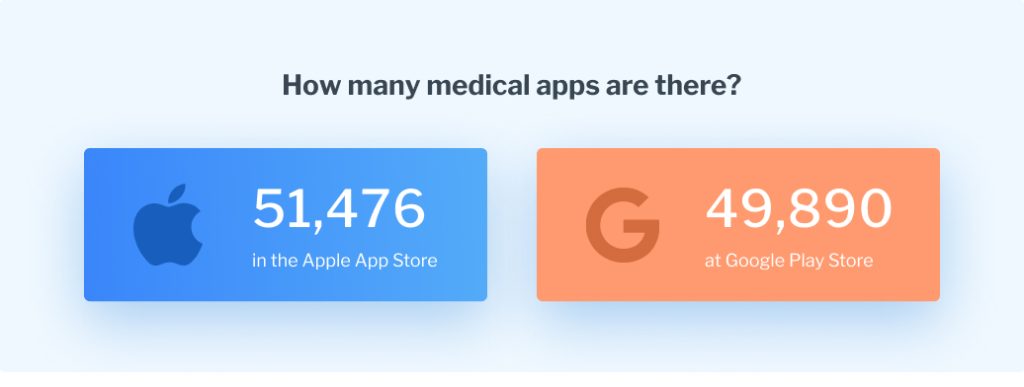We use cookies to ensure we give you the best experience on our website. By clicking Agree you accept our Privacy and Cookies Policy.
How to develop a medical app for doctors: everything you need to know

Mykhaylo Terentyak
Author

March 3, 2024
Date

 14 minutes read
14 minutes read
Content
Over the past five years, technologies have shaken up the healthcare industry and changed the way doctors work. Medical apps for doctors adjusted every aspect of healthcare practice, optimizing mundane tasks and collaboration between specialists. Different medical apps solve different problems. In this article, we will take a closer look at the mobile health industry and its various players.
The state of the mobile health market: analyzing the rapid growth
The global mobile health market is booming. It was estimated at $40 billion in 2020 and will reach $149 billion by 2028. What are the main factors driving the mHealth market growth?
- Digital disruption. The penetration of smartphones is growing year after year, and now there are 3.6 billion smartphone users on the planet — or 46% of the global population. The 4G network coverage reached 85% in 2020, contributing to further mobile adoption in developed and developing countries.
- Rising adoption by healthcare professionals. The new generation of doctors includes tech-savvy millennials looking for technological solutions to improve the quality of care and doctor-patient interaction.
- Increase in chronic diseases. As the population ages, chronic conditions such as diabetes, asthma, osteoporosis, cardiovascular disease, and others become more common and require continuous remote monitoring and therapy.
- The impact of COVID-19. The global pandemic turned digitalization from luxury to necessity, urging industries to adapt and modernize at the double. In 2020, COVID-19 lockdowns increased the worldwide usage of mobile health platforms by 65%
All these factors have prepared solid ground for the rapid escalation of the mobile health industry. Soon, mHealth solutions will be integrated into healthcare in the same way fintech was integrated into banking systems.

The benefits of medical apps for doctors and patients
We’ve skimmed through many reasons behind the mHealth market growth, but the first and foremost reason is the advantages of using medical apps. Mobile health apps cover all aspects of medical practice and provide better control, productivity, and safety for all the parties involved. Without further ado, check out the benefits of using mHealth apps:
- Eliminate medical errors
- Reduce spending for patients and hospitals
- Offer a smarter approach to medical tests
- Automate paperwork
- Assist in the complex treatment
- Improve patient-doctor communication
- Collect and analyze patient data
- Support a healthy lifestyle
Furthermore, mHealth solutions can integrate with wearable tech and other devices. It helps doctors to retrieve, monitor, and analyze patient health data in just one click.
Types of medical apps for doctors: the best players in the field
Before you jump into brainstorming your app’s features and design, you should have a clear vision of existing types of mobile apps on the market. Analyzing competitors is also part of the process, as you can find functionality gaps and fill them with your solution.
We’ve compiled the most popular app categories that make a difference for healthcare providers.
Reference and diagnostic support platforms
The number of overall diagnostic errors reaches 31 million annually in North America alone. These mistakes cost the healthcare system $750 billion a year. That’s why doctors double-check the information during the diagnostic process. Diagnostic support apps assist in making important clinical decisions. They provide quick access to medical knowledgebase about diseases, drugs, and the latest clinical discoveries.
For example, VisualDX serves as a reliable second opinion in clinical decisions regarding skin problems. It has the biggest medical image base along with AI-powered lesion morphology identification for every skin type. Non-dermatologists increase diagnostic accuracy to 68% by using this app.
Epocrates is a clinical decision support tool that integrates multiple features. It provides disease knowledgebase, clinical guidelines, extensive information about drugs and their interactions, pill identification, dosing calculators, and access to drug coverage data for over 6,600 insurance plans. In 2010, Epocrates user base seized 40% of all physicians in the US.
Patient health record platforms
Electronic Health Record (EHR) solutions improve workflows throughout the healthcare delivery process. By storing all patient data in one place, these platforms provide instant access to lab results, radiographic images, clinical notes, patient charts, treatment history, and other clinical information to doctors and nurses. As a result, physicians get a complete picture of the patient’s condition to make a well-balanced clinical decision.
AirStrip One is the FDA-approved platform that stores patient information from medical devices, EHR, laboratory orders, ECG waveforms, etc., providing clinical data visualization and decision aid out-of-the-box. More than 300 hospitals in the US choose this doctor application.
Another player in the EHR software field is RXNT — a cloud-based system that provides easy access, seamless exchange, and streamlined patient data management for all clinical practices and specialties. Moreover, it comes with an integrated patient portal for booking appointments, paying bills, and secure doctor-patient communication.
Appointment booking platforms
Appointment scheduling can be a real mess even in small medical centers, not to mention large clinics with multiple departments. Automated appointment management systems handle rescheduling and cancellation on-the-fly and fill last-minute openings without any manual effort.
ZocDoc finds local healthcare specialists covered by the patient’s insurance plan. It handles booking for primary care specialists, dentists, OB-GYNs, dermatologists, psychiatrists, and eye doctors. The rating and review system enables doctors to reach a new audience and strengthen their reputation.
SimplyBookMe enables accepting bookings from various channels, such as Facebook, Instagram, Google Maps, website widgets, etc. It also serves as a marketing tool by promoting a medical facility on social media platforms and providing SEO support.
Telehealth platforms
Telemedicine apps have been on the rise since the first wave of COVID-19. Online doctor visit rates increased by 50% in the first quarter of 2020 compared to the same period in 2019. Many patients enjoy remote consultations from home, and healthcare providers benefit from reducing cancellations. Surprisingly, remote consultations are as effective as traditional brick-and-mortar appointments: 85% of telemedicine visits fully resolve patient concerns.
HeyDoctor offers affordable treatment and medicine refill services for common health conditions. It follows a fixed-price model so that patients without insurance can get professional advice via live chat.
Doctor on Demand is an app for online doctor consultation that provides urgent, preventive, and chronic care. The platform supports video calls and integrates with Apple’s HealthKit and Google Fit. Ninety-eight million Americans choose Doctor on Demand, placing it in the top 3 most successful telehealth solutions.
Patient engagement platforms
Patient care shouldn’t end after hospital discharge. Most health issues require post-treatment, so it’s essential to provide continuous care and engagement for patients. Patient engagement apps enable sending updates and notifications, displaying personal instructions, and reminding them to take medication on time.
Luma Health automates doctor-patient communication through text messaging and reduces no-shows and backfill cancellations by 79%. The app supports EHR platform integration, patient scheduling, health screening features, and more.
AC Health benefits both doctors and patients by providing a tool for creating custom physical/occupational therapy exercises. With this app, doctors can record and edit individually tailored video exercises and increase overall patient engagement in the recovery process.
Medical practice management platforms
Medical practice management systems automate dozens of tasks, including scheduling, billing, online booking, EHR, CRM, stocks and inventory, reports and analytics, task management, training and support, payroll management, and others. Many of them integrate with lab machines and biometric devices, serving as a comprehensive ecosystem for all medical.
Medesk is an all-in-one system that brings together everything a private medical practitioner needs. Besides basic EHR and billing features, it provides healthcare metrics to improve financial performance and built-in telehealth solutions.
Vital Hub provides integrated patient flow, operational visibility, case management, EHR, documentation flow, and care coordination solutions specifically designed for complex hospital environments. The system connects different teams to support efficient patient-centered care and eliminate hallway medicine.

Types of mobile health apps for patients: self-care on-the-go
Despite plenty of apps in the wellness category, we target those with a medical focus. Patient mobile applications are easy-to-use helpers for people that undergo extensive treatment or handle chronic health conditions.
Health tracking platforms
These platforms help manage complex chronic conditions by checking symptoms, integrating and analyzing the data from IoT devices, giving medical advice, and providing real-time insights about a patient’s wellbeing.
WellDoc is a combo of a virtual coach, health monitor, medication manager, and lifestyle advisor. Their digital health solutions for type 1 and type 2 diabetes are FDA-backed and compatible with Dexcom glucose monitoring devices.
Ada health-tracking app assists in making better health choices based on AI and clinical evidence. An extensive medical library and intelligent algorithms adapt to personal health profiles, improve self-diagnosis accuracy, and deliver trusted medical advice.
Medication reminder platforms
Everyone needs to take medication once in a while. For elders or people with chronic conditions, pills become an inherent part of life. Medication trackers help follow numerous dosage schedules. They combine multiple dosage regimes, send reminders, and alert patients about drug and food interactions.
ScriptSave WellRx is a solution for tracking meds in nearby pharmacies, finding the best prices, and taking them on schedule. The app integrates with Rx savings card, enabling customers to save up to 65% on medications.
Medisafe is the #1 medication reminder trusted by 6 million people worldwide. It takes the trouble of managing complex drug prescriptions by providing drug intake and refills reminders, interaction warnings, and family schedule management.
Mental health platforms
Mental wellbeing apps gained recognition among specialists and users for being more accessible and flexible than traditional psychotherapy. These solutions can assist with psychiatric treatment plans for coping with depression, anxiety, eating disorders, sleep disorders, and more. They also serve as an affordable replacement for expensive mental health counseling.
MoodMission is created by mental health professionals for coping with depression and anxiety. It suggests mood-boosting activities based on proven CBT methods and offers in-app rewards to increase user’s motivation.
Shine provides science-backed mental support specified for people of color. It displays motivational texts and videos that help deal with stress, anxiety, burnout, and other frustrations. Users can also access the inclusive community for additional support.
6 essential steps of healthcare mobile app development
So, you’ve done your research and selected the market niche and the type of your mHealth app. Now it’s time for planning and estimating the project scope, budget, and main features of your product. Healthcare mobile app development can be daunting and time-consuming unless you’re well prepared.
Follow these steps to make sure you don’t miss out on anything important.
Understand your audience
Target audience analysis is a crucial part of your product discovery phase. The target audience represents more than just users of your app. It’s a huge market segmented by various factors, including country, gender, age, education, income level, lifestyle, etc.
There’s no way to build a successful medical app without understanding users’ needs. Each region has its specifics and regulations, so start by choosing the targeted countries for your platform. In 2020, the global mobile health market revenue share in North America was 38%. Europe and the Asia-Pacific took other parts of the pie with shares of over 25%.
Your audience research will give you a clue on necessary features and general expectations from a mHealth app.
Outline core features for MVP
Unfortunately, you cannot have all the cool features at once — otherwise, the development time and cost will be outrageous. That’s why you should separate must-have from nice-to-have features for your MVP. If you’re stuck on prioritizing the features, business analysis will help you better understand your product requirements and business needs.
The key features of your medical app for doctors will depend on the chosen application type. Here is a brief list of mHealth apps functionality:
- Patient data monitoring
- Secure doctor-patient communication
- File exchange
- Appointment scheduling
- Integration with EHR
- Integration with payment systems
- Integration with Google Kit and Health Kit
- AI health assistant
- Progress tracking and analytics
- Cloud data storage
- Cross-platform accessibility
- Notifications
Go for essential features that reflect your app’s concept in the first place. You can always add more functionality after the MVP is released.
Take care of UX/UI design
While the fancy design is not a must for a medical application, usability could be the turning point for your app’s success. Paying attention to UX and UI design ensures smooth interaction between the users and your brand.
Follow these rules to make your healthcare app user-friendly:
- Optimize user journey. Make all actions as easy as possible.
- Choose an ergonomic information architecture. Highlight core features with UI design.
- Make sure your design is responsive. Adapt the app’s interface to various platforms and screen sizes.
- Empathize with your users. Find out what your audience needs and give it to them.
- Test your design. Validate your ideas through usability testing and user feedback to upscale your app.
You can choose a more conservative or modern design depending on your target audience’s preferences. Planning all details and visualizing them with design prototypes will save you costs and shorten time to market.
Pick a dedicated development team
The qualifications and experience of the chosen development team make a big difference in the prosperity of your product. Hiring in-house developers increases the project cost and requires additional time while working with freelancers doesn’t guarantee the expected result.
The best option is to choose a close-knit team with experience in healthcare mobile app development. Entirely focused on your project goals, it takes care of the whole development process from hiring to project management. A dedicated team accelerates the product development lifecycle and provides smooth and effective communication to achieve the best possible result.
Consider security compliance
Since healthcare applications handle a lot of personal information, it’s vital to keep patient data safe by complying with legal and privacy regulations. The following list includes regulations needed for medical apps within the US market:
- HIPAA. Adherence to HIPAA is mandatory for all apps that process and store Protected Healthcare Information (PHI) such as CT and MRI scans, lab results, and doctor’s notes.
- CCPA. This law informs patients about the collected data, provides reports, and removes the data at the request.
- NIST. It’s a cybersecurity framework that offers a wide range of tools and services explicitly for mHealth applications.
In other words, there is no way of launching a medical app without following cybersecurity standards.
Choose app monetization model
Whether you’re building a medical app or any other app, you can choose from the same list of monetization strategies. Your options include:
- Freemium. The idea is to give access to basic features while offering advanced functionality for a premium account.
- Certified content. This strategy involves providing free access to a limited amount of content. After users reach the limit, they need to sign up and pay for a subscription.
- Relevant advertising. You can bet on targeted mobile ads that use GPS or beacon-based localization.
- Subscription model. Offer different subscription plans for doctors or patients.
Whichever monetization strategy you choose, make sure it’s not annoying or disruptive for user performance.

Our experience: Software for dental diagnostics and treatment design
Being on the market since 2011, Blackthorn Vision has developed software for Fortune 500 companies and successfully launched over 70 projects. Our expertise includes developing cloud-based, HIPAA-compliant, multiplatform web solutions for diagnostics and treatment.
The software we created optimizes dental practice workflows and assists dentists throughout the treatment process. The app’s algorithms analyze 3D dental scans and other data to offer proper examinations and a treatment plan. Dental Helper eliminates medical errors, enhances collaboration between specialists, and sets up effective doctor-patient communication.
So, if you want to jump on the back wagon of the mHealth industry and look for an experienced software development team, contact us! Our specialists will gladly share their insights about your medical app project.




































































